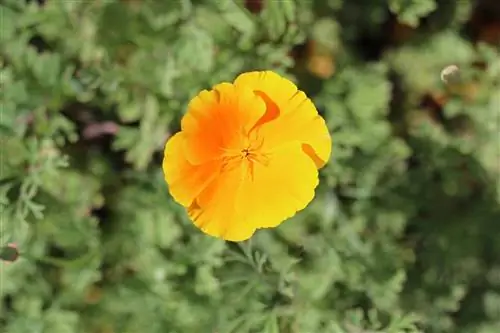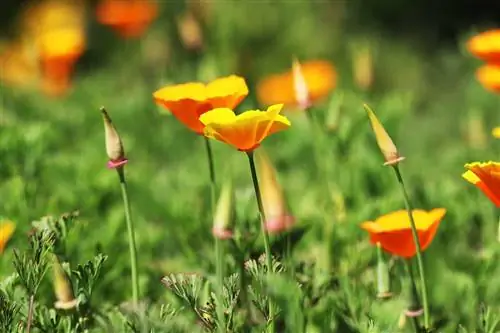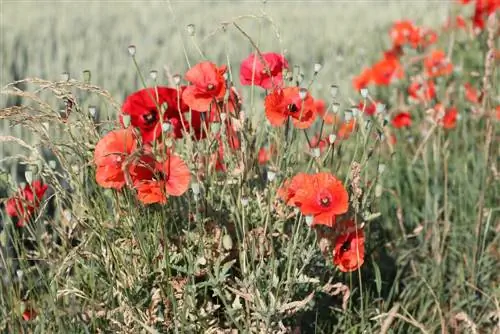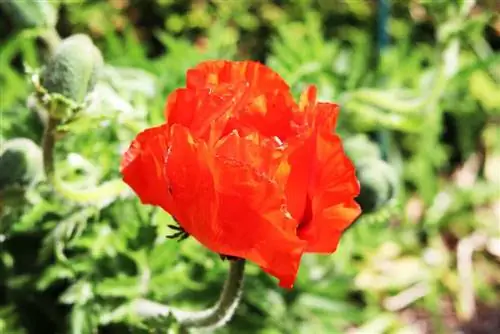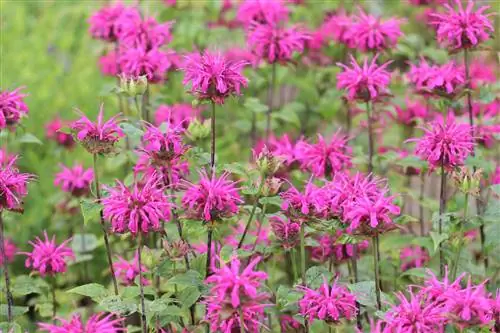- Author admin [email protected].
- Public 2023-12-17 03:39.
- Last modified 2025-01-24 12:45.
The name gold poppy, Californian poppy or Eschscholzia californica always refers to the same plant, which is also often called the sleepyhead. The golden poppy belongs to the poppy family (Papaveraceae) and has its origins in California and other states in the southwest of the USA. However, it can now also be found in Australia, South Africa and of course also in Europe.
Special features of the golden poppy
Gold poppy is an annual and does not exactly impress with its lush growth of herbs and leaves. As a bare plant, it shows off its bright yellow flowers all the better, which can be on a stem up to 60 cm high. The plant can grow slightly branched from the base, with leaves arranged in a rosette shape. These have a gray-green hue and can grow up to 14 cm long.
- Gold poppy is an annual plant.
- It grows in its homeland at altitudes of up to 2,000 meters.
The yellow flowers of the golden poppy grow either from the leaf axils or at the end of the long stem. The flower bud develops from the initially round shape into a cone-shaped shape, when the flowers open they look similar to small plates. They can reach sizes between 2 and 12 cm. In most cases there is a dark yellow to orange spot in the middle of the flower, also called the flower base. Before the flower can open, it is surrounded by two sepals. These sepals are shaped like a nightcap, as was worn in the Middle Ages. This has also earned the golden poppy the name “sleepyhead”. Once the petals begin to open, the two leaves are stripped and fall off as one component.
- The flowering period is from July to September.
- Seeds ripen from August to September.
When the seeds are developed after flowering, they sit in thick pods that are approximately 10 cm long. These have a single seed chamber and consist of 10 longitudinal ribs. After the seeds have ripened, these longitudinal ribs open in two places through which the brown seeds can fall out.
Attention:
The golden poppy is poisonous in all parts!
There are now only two subspecies of the golden poppy, that is the Eschscholzia californica subsp. Californica and E. mexicana. While californica has a pronounced wide edge of the flower base, mexicana lacks this completely. The golden poppy mexicana occurs in more desert-like regions, the californica in grassy, open areas.
Distribution areas of the California poppy
The golden poppy originally comes from California, which is where its survival strategy comes from. Not only is it very diverse - over 90 species are known - it is also a survival artist. It is used to dryness and drought, its seeds can survive in dry soil for years. As soon as they receive moisture, they begin to germinate and bloom. Then entire fields full of poppies can be seen in California or southwest America, making the entire region shine yellow.
The flowers of the golden poppy only open when the sun is shining. They close at night and when the weather is cloudy or rainy. Golden poppy propagates through wind dispersal and the flowers are pollinated by insects. The golden poppy can tolerate temperatures down to -10°C.
- The height reaches 20 to 40 cm.
- Sunny and warm location necessary!
California poppy became more and more widespread, so that it was eventually cultivated as a garden plant in Europe. It has been an integral part of English garden beds since 1825. After being named California's state flower in 1903 - the golden flowers and Golden State go well together - California Poppy Day is celebrated every year on April 6th.
Tip:
Gold poppy also has a special medicinal significance.
Gold poppy is known as a medicinal plant by the Native Americans and also from the Middle Ages in Europe. Its effect is due to sleep-inducing substances, antispasmodic, pain-relieving and calming ingredients. The golden poppy is particularly valuable in the treatment of children, here mostly in the area of psychology.
Sowing the golden poppy in the home garden
According to its origin, the golden poppy also prefers a sunny and hot location in our gardens. Then it can develop its flowers, which are not formed in all other weather conditions. The golden poppy prefers a light, sandy to loamy soil. Then it can thrive very well and develop its golden flowers. If possible, the soil should not be prepared at all, this is what the plant prefers.
When sowing, it is planted immediately where it is supposed to bloom. It is not possible to move the plant; long taproots prevent this. For sowing, furrows with a depth of 1 cm are made. In April and May, the small plants are thinned out at a distance of around 10 cm and always kept well moist.
Tip:
Plant either as a group or together with sea lavender or blue woodruff.
From spring to late summer, the golden poppy shows its beautiful yellow to orange flowers. When these have wilted, they should be removed to encourage new flowers to form. Towards the end of the flowering period, the withered flower heads can be left to allow the seeds to mature. These can then be harvested and used again for the next sowing in autumn or spring.
- Regular watering in dry conditions!
- Do not apply fertilizer!
Gold poppy flowers cannot be used as cut flowers, they would immediately drop the petals after cutting.
What you should know about the gold poppy in brief
Gold poppy is a colorful addition to the garden, its flowers are available from yellow to orange to a red hue. Once planted in place, it cannot be transplanted because its taproots would be damaged during digging. Otherwise, the golden poppy is a relatively undemanding plant, requiring sun and slightly moist, normal soil. Its seeds can be used for re-sowing. This means that the golden poppy is not only easy to care for, but also a special eye-catcher in the garden until early autumn.
Tips for speed readers
- Gold poppy comes from California, also called California cap poppy.
- It blooms profusely in a sunny location.
- It grows up to 40 cm high.
- Flower color: from white to yellow to orange and red
- Soil: preferably dry and nutrient-rich, light, sandy soil with some clay, no soil preparation necessary
- Sowing: Direct sowing in May, no transplanting, thin out to 10 cm
- Variety: 'Inferno' with very bushy growth and flowers in strikingly bright orange

